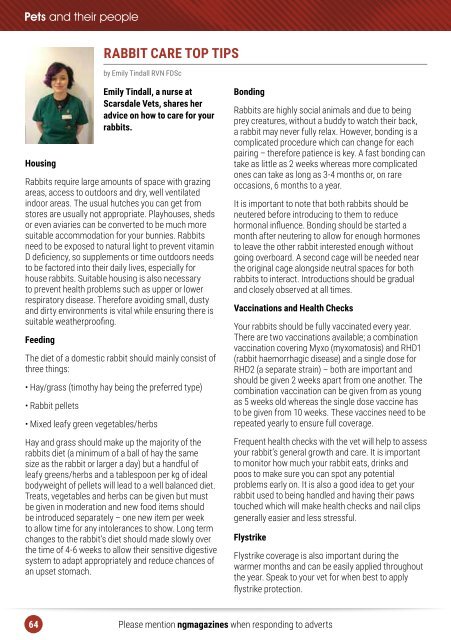NG8 July/August 2020
Local business directory and community magazine.
Local business directory and community magazine.
Create successful ePaper yourself
Turn your PDF publications into a flip-book with our unique Google optimized e-Paper software.
abbit care top tips<br />
by Emily Tindall RVN FDSc<br />
Housing<br />
Emily Tindall, a nurse at<br />
Scarsdale Vets, shares her<br />
advice on how to care for your<br />
rabbits.<br />
Rabbits require large amounts of space with grazing<br />
areas, access to outdoors and dry, well ventilated<br />
indoor areas. The usual hutches you can get from<br />
stores are usually not appropriate. Playhouses, sheds<br />
or even aviaries can be converted to be much more<br />
suitable accommodation for your bunnies. Rabbits<br />
need to be exposed to natural light to prevent vitamin<br />
D deficiency, so supplements or time outdoors needs<br />
to be factored into their daily lives, especially for<br />
house rabbits. Suitable housing is also necessary<br />
to prevent health problems such as upper or lower<br />
respiratory disease. Therefore avoiding small, dusty<br />
and dirty environments is vital while ensuring there is<br />
suitable weatherproofing.<br />
Feeding<br />
The diet of a domestic rabbit should mainly consist of<br />
three things:<br />
• Hay/grass (timothy hay being the preferred type)<br />
• Rabbit pellets<br />
• Mixed leafy green vegetables/herbs<br />
Hay and grass should make up the majority of the<br />
rabbits diet (a minimum of a ball of hay the same<br />
size as the rabbit or larger a day) but a handful of<br />
leafy greens/herbs and a tablespoon per kg of ideal<br />
bodyweight of pellets will lead to a well balanced diet.<br />
Treats, vegetables and herbs can be given but must<br />
be given in moderation and new food items should<br />
be introduced separately – one new item per week<br />
to allow time for any intolerances to show. Long term<br />
changes to the rabbit’s diet should made slowly over<br />
the time of 4-6 weeks to allow their sensitive digestive<br />
system to adapt appropriately and reduce chances of<br />
an upset stomach.<br />
Bonding<br />
Rabbits are highly social animals and due to being<br />
prey creatures, without a buddy to watch their back,<br />
a rabbit may never fully relax. However, bonding is a<br />
complicated procedure which can change for each<br />
pairing – therefore patience is key. A fast bonding can<br />
take as little as 2 weeks whereas more complicated<br />
ones can take as long as 3-4 months or, on rare<br />
occasions, 6 months to a year.<br />
It is important to note that both rabbits should be<br />
neutered before introducing to them to reduce<br />
hormonal influence. Bonding should be started a<br />
month after neutering to allow for enough hormones<br />
to leave the other rabbit interested enough without<br />
going overboard. A second cage will be needed near<br />
the original cage alongside neutral spaces for both<br />
rabbits to interact. Introductions should be gradual<br />
and closely observed at all times.<br />
Vaccinations and Health Checks<br />
Your rabbits should be fully vaccinated every year.<br />
There are two vaccinations available; a combination<br />
vaccination covering Myxo (myxomatosis) and RHD1<br />
(rabbit haemorrhagic disease) and a single dose for<br />
RHD2 (a separate strain) – both are important and<br />
should be given 2 weeks apart from one another. The<br />
combination vaccination can be given from as young<br />
as 5 weeks old whereas the single dose vaccine has<br />
to be given from 10 weeks. These vaccines need to be<br />
repeated yearly to ensure full coverage.<br />
Frequent health checks with the vet will help to assess<br />
your rabbit’s general growth and care. It is important<br />
to monitor how much your rabbit eats, drinks and<br />
poos to make sure you can spot any potential<br />
problems early on. It is also a good idea to get your<br />
rabbit used to being handled and having their paws<br />
touched which will make health checks and nail clips<br />
generally easier and less stressful.<br />
Flystrike<br />
Flystrike coverage is also important during the<br />
warmer months and can be easily applied throughout<br />
the year. Speak to your vet for when best to apply<br />
flystrike protection.<br />
64 Please mention ngmagazines when responding to adverts


















